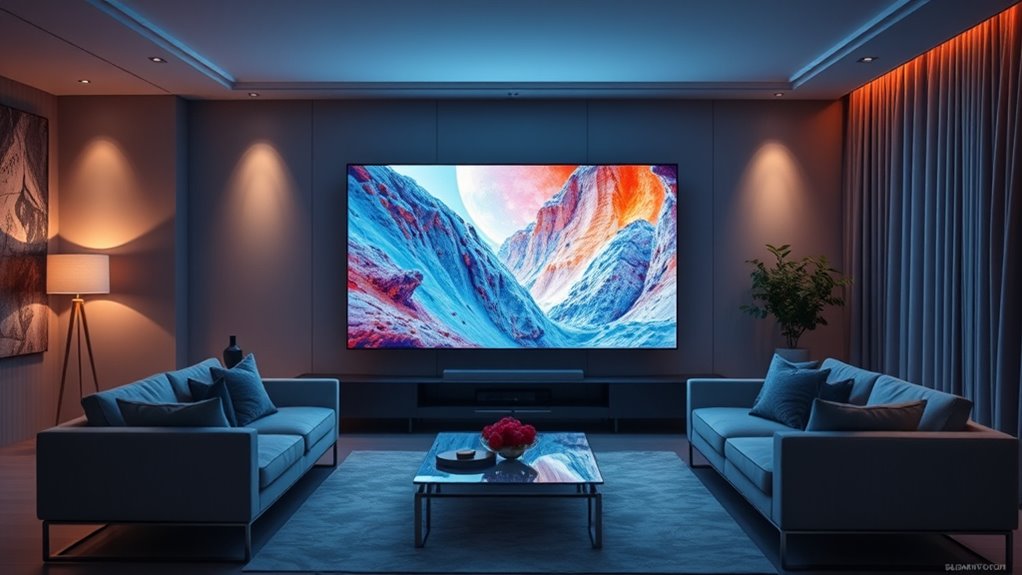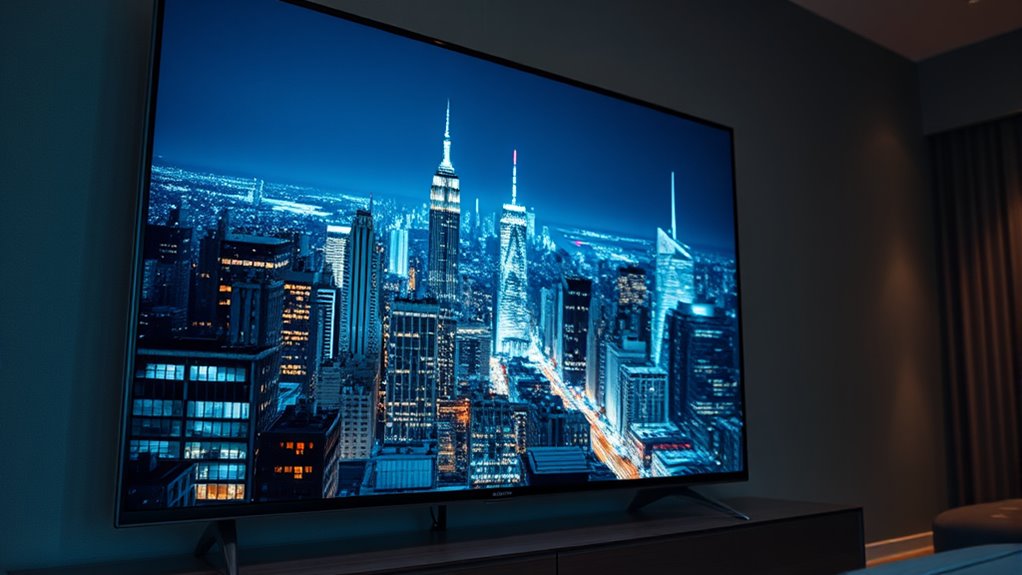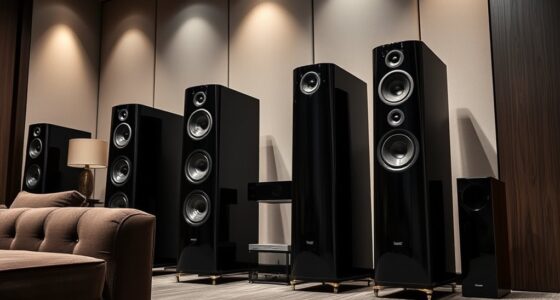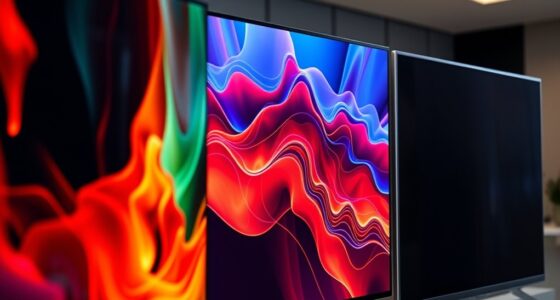Whether 8K is overkill depends on your viewing habits and setup. If you have a large screen, sit close, or enjoy ultra-detailed images, 8K can make a noticeable difference. However, for casual viewers with smaller screens or distant seating, the benefits may be minimal. Content availability and hardware costs also play a role. To understand if upgrading is worth it for you, explore the factors that determine when ultra-high resolution truly makes an impact.
Key Takeaways
- 8K offers significant benefits for large screens and close viewing, enhancing detail and immersion.
- Content availability and device support for 8K are still limited, reducing practical overkill concerns.
- Higher costs and bandwidth requirements may outweigh benefits for casual or smaller-scale viewers.
- Human visual acuity means most people won’t notice 8K differences on smaller screens or from a distance.
- 8K is more suited for professional, cinematic, or future-proof setups rather than everyday casual viewing.
Understanding the Difference: 4K vs. 8K

Have you ever wondered how 8K compares to 4K? The key difference lies in resolution, but it also impacts color accuracy and refresh rate. 8K offers four times the pixels of 4K, delivering sharper images and more detail. This means your screen can display more precise colors and subtle gradients, enhancing overall image quality. Additionally, high refresh rate is essential to fully appreciate 8K’s benefits, especially for fast-moving scenes, ensuring smooth motion. While 4K already provides excellent clarity, 8K pushes the boundaries further, creating an immersive viewing experience. Furthermore, screen size and viewing distance play a significant role in whether the higher resolution makes a noticeable difference. The Suprem fabric trend in textiles exemplifies how innovation can elevate quality and durability, much like how 8K can improve visual fidelity. Still, the real advantage depends on your content and hardware capabilities. If your system can support it, 8K can elevate your visual experience, but for many, 4K remains a practical and stunning choice. Furthermore, display features such as user-friendly interfaces and high-quality components can further improve your viewing experience.
When Does Screen Size Matter for 8K?

Your screen size plays a key role in whether 8K truly makes a difference. Larger displays boost pixel density and detail, especially when you’re close enough to notice the difference. Keep in mind, your viewing distance also impacts how much 8K resolution improves your experience. For a cozy farmhouse bedroom, choosing the right home decor can make your space feel both comfortable and visually stunning.
Screen Size Impact
When considering the impact of screen size on 8K resolution, it’s vital to recognize that larger displays can considerably enhance image clarity and detail. With a bigger screen, the benefits of 8K become more noticeable, especially if you sit closer. The key is matching your screen size to your viewing distance; a larger screen requires you to sit farther back to avoid pixel visibility. If your viewing distance is too close for a given screen size, the ultra-high resolution won’t make much difference because you’ll still notice individual pixels. Conversely, a larger screen at the right distance allows you to fully appreciate 8K’s sharpness and detail. Ultimately, the impact of screen size depends on balancing display dimensions with how close you sit to the screen. Additionally, understanding pixel visibility and how it affects viewing experience can help determine the optimal screen size for your setup. Considering visual acuity and the human eye’s capacity to distinguish detail can further refine your choice of screen size for 8K content. Recognizing the human visual system capabilities can help you determine when the higher resolution truly benefits your viewing experience. Moreover, display technology advancements play a significant role in maximizing the benefits of high-resolution screens.
Pixel Density Considerations
Pixel density plays an essential role in determining when screen size truly matters for 8K displays. If your screen is too small, the high pixel count becomes less noticeable, and you might not see a significant difference in image sharpness. However, as screen size increases, pixel density impacts your viewing experience, especially in terms of color accuracy and panel technology. Higher pixel density ensures sharper images and more precise color reproduction, making details pop without pixelation. Panel technology also influences how effectively your display utilizes 8K resolution; advanced panels provide better uniformity and color accuracy, which are key on larger screens. Additionally, display resolution advancements continue to improve how 8K content is rendered, further enhancing visual quality on larger screens. Ultimately, for larger screens, higher pixel density amplifies the benefits of 8K, making the investment worthwhile when you want immersive, detailed visuals.
Viewing Distance Effect
While high pixel density enhances image clarity, the impact of screen size on your viewing experience depends largely on how close you sit to the display. If you sit far back, a larger 8K screen won’t make much difference in color accuracy or detail; your eyes can’t resolve the extra pixels. However, sitting closer allows you to appreciate the increased resolution, making small details sharper and colors more vibrant. Remember, sound quality also influences your experience—larger screens can sometimes amplify audio imperfections. Ultimately, the size matters when your viewing distance aligns with the screen’s resolution. If you’re close enough, 8K can deliver a more immersive, detailed picture, but at greater distances, the benefits diminish, making 8K overkill for casual viewing. Additionally, understanding your vetted options can help you choose the best display for your needs. Furthermore, considering viewing ergonomics can help you determine the optimal screen size and placement for a comfortable experience. Recognizing the visual acuity of your eyes can also guide your decision on whether higher resolution truly enhances your viewing pleasure. Being aware of display technology can further influence your choice, especially when considering color accuracy and refresh rates.
Content Compatibility and Availability

You might find that not all content supports 8K resolution yet, limiting your options for variety and format. Device and platform support can also vary, affecting how easily you access and enjoy 8K content. As a result, compatibility and availability become key factors in whether 8K is worth it for you. Additionally, the current focus of content‑based tutorials and project‑based how‑tos may not yet fully leverage the potential of 8K resolution. Furthermore, the exponential increase in data requirements for 8K content can pose challenges for streaming and storage, especially considering content formats and their compatibility with existing hardware. The user experience may also be impacted if devices are not yet optimized for such high resolutions.
Content Variety and Formats
As 8K technology advances, the variety and compatibility of content formats become increasingly important. You need to make sure your content aligns with resolution standards and can handle the high data demands of 8K displays. Not all formats are created equal, so check if your favorite streaming services offer native 8K content. Proper display calibration is also essential to fully enjoy the clarity and detail. Additionally, understanding emotional support can help viewers cope with the high expectations and potential frustrations of upgrading to 8K technology. Some key points to consider include: – Compatibility of streaming platforms with 8K formats – Availability of native 8K movies and TV shows – Support for different codec and container formats – Quality variations across streaming providers – The importance of resolution standards in content production Staying aware of these factors helps you maximize your 8K experience.
Device and Platform Support
Ensuring your device and platform support 8K content is essential to enjoying the highest resolution. Not all devices are 8K-ready, especially when it comes to mobile compatibility. Streaming services vary in their support—some offer 8K streams, while others lag behind. To visualize, consider this table:
| Device Type | Availability of 8K Support | Compatibility with Streaming Services |
|---|---|---|
| Smartphones | Limited, newer models | Few services offer 8K streaming |
| TVs | Increasing support | Major platforms expanding 8K content |
| Monitors | Growing support | Limited streaming options |
| Laptops | Emerging support | Varies by platform |
| Streaming Boxes | Partial support | Most major services adding 8K |
Check your device specs and streaming subscriptions to make certain you can truly experience 8K content.
The Impact of Viewing Distance on Perceived Detail

The perceived detail of an 8K display depends heavily on how close you sit to it. When you’re closer, your visual acuity allows you to notice finer details that seem invisible from farther away. As you move back, the high resolution becomes less noticeable; your eyes can’t resolve the extra pixels. Room lighting also plays a role—bright environments can wash out subtle details, reducing the impact of ultra-high resolution. To maximize perceived detail:
- Sit within a few feet of the screen
- Reduce ambient light for sharper contrast
- Consider your visual acuity limitations
- Avoid sitting too close, which can cause discomfort
- Maintain proper room lighting to enhance clarity
Adjusting your viewing distance and lighting setup guarantees you experience the true benefits of 8K’s detail, especially if your eyes are sharp and your room is optimized.
Gaming and 8K: Is It Worth the Investment?

While viewing distance and lighting influence how much detail you perceive on an 8K screen, gaming introduces a different set of considerations. The resolution benefits of 8K are impressive, but they depend heavily on your gaming performance. Higher resolutions demand more from your GPU, which can lead to reduced frame rates if your hardware isn’t top-tier. For casual gamers, the visual improvements might be subtle, making 8K overkill for now. However, if you have a high-end setup, you could enjoy sharper images and more immersive experiences. Still, the additional processing power required may not justify the investment for most gamers today, as current games often prioritize frame rates over ultra-high resolutions. Ultimately, whether 8K is worth it depends on your gaming goals and hardware capabilities.
Professional Use Cases Where 8K Excels

Professionals working in fields like video editing, 3D rendering, and medical imaging find 8K displays invaluable because they require exceptional detail and accuracy. In art installations, 8K can capture intricate visuals that immerse viewers fully. Scientific imaging benefits from the high resolution by revealing minute details impossible at lower resolutions. For example, detailed medical scans or complex data visualizations become clearer and more precise. Additionally, 8K enhances large-scale visual presentations, making them more impactful. Use cases include:
- Creating immersive art installations with sharp, detailed visuals
- Conducting precise scientific imaging and analysis
- Producing high-quality visual effects for films
- Facilitating detailed 3D modeling and rendering
- Enhancing virtual reality experiences with crisp clarity
This level of resolution guarantees professionals can push creative and technical boundaries with confidence.
Future-Proofing Your Home Entertainment System

As 8K displays become more accessible, investing in one now can help future-proof your home entertainment system, ensuring you’re ready for upcoming advancements in content and technology. With the rise of high-resolution video streaming services, having an 8K TV positions you to enjoy sharper, more detailed images as content evolves. To keep up, you might need hardware upgrades like faster processors, HDMI 2.1 support, or improved sound systems. This way, your setup remains compatible with future streaming devices and new features. Future-proofing isn’t just about the display; it’s about preparing your entire system for seamless integration with emerging tech. Investing now means you won’t need to replace everything later, saving you time and money while enhancing your viewing experience.

Deciding whether to invest in an 8K TV involves weighing the significant price premium against the tangible benefits it offers. If your viewing habits include large screens and close-up viewing, the sharpness and detail can enhance your experience. However, if you mainly watch streaming content or prefer smaller screens, the added cost may not justify the upgrade. Consider these factors:
Weigh the cost and benefits of 8K TVs, especially for large screens and close viewing.
- Higher price point compared to 4K models
- Marginal improvements for casual viewers
- Limited 8K content availability
- Greater benefit with larger screens and closer seating
- Potential for future content upgrades
Ultimately, ask yourself if the enhanced resolution aligns with your entertainment style and whether the investment feels justified given current content and your viewing environment.
Technological Limitations and Challenges of 8K Displays

While 8K displays boast impressive resolution, they face significant technological hurdles that limit their current practicality. One major challenge is the display resolution itself, which demands more powerful hardware to process and render content smoothly. Hardware limitations, such as graphics cards and processors, struggle to handle the immense data load, resulting in potential lag or reduced performance. Additionally, current storage and bandwidth constraints make streaming or transmitting 8K content difficult and costly. Manufacturing such high-resolution screens also presents obstacles in maintaining image quality, color accuracy, and uniformity across large panels. These technological limitations mean that, despite the allure of ultra-high resolution, widespread adoption remains hindered by hardware capabilities and infrastructure not yet ready to support seamless 8K experiences.
Making an Informed Choice: Factors to Consider Before Upgrading

Before upgrading to an 8K display, you should consider whether your current content will truly benefit from the higher resolution. Think about your budget and whether the added cost offers good value for your needs. Making an informed choice means weighing content compatibility, financial factors, and how much you’ll actually enjoy the upgrade.
Content Compatibility Needs
To determine if upgrading to 8K is worth it, you need to contemplate whether your current content is compatible with the higher resolution. Not all streaming platforms support 8K, and streaming limitations can restrict playback quality. Content licensing also plays a role, as some services may not have 8K versions of their titles. Additionally, consider whether your existing media library includes 8K content or if you’ll need to upgrade your subscriptions. Keep in mind that streaming limitations might cause buffering or reduced quality if your internet isn’t fast enough. If your favorite shows or movies are only available in lower resolutions, investing in 8K might not deliver the expected benefits. Ensuring your content matches the resolution ensures you get the most out of your upgrade.
Budget and Value
Deciding whether to upgrade to 8K depends heavily on your budget and whether the value justifies the cost. If you have strict budget limitations, investing in 8K might not be practical, especially since prices are still high. Conducting a thorough value assessment helps determine if the benefits outweigh the expense. Consider whether you’ll notice a significant improvement in picture quality or if your current setup already meets your needs. Remember, additional costs for compatible content, accessories, and possible internet upgrades can increase the total investment. If the upgrade strains your budget or doesn’t provide a noticeable difference, it’s worth delaying. Making an informed choice means weighing these factors carefully to ensure you get the most value out of your purchase.
Frequently Asked Questions
How Does 8K Impact Energy Consumption of Displays?
8K displays do increase energy consumption compared to lower resolutions because they require more power to run the higher pixel count. This heightened energy use can contribute to a bigger environmental impact, especially if you frequently use large, high-end screens. If energy efficiency matters to you, consider how often you’ll use an 8K display and whether the visual benefits outweigh the increased environmental footprint.
Are There Health Risks Associated With 8K Screens?
You might wonder if 8K screens pose health risks, but current research shows minimal danger. While eye strain and visual fatigue can occur with prolonged use, these issues aren’t specific to 8K displays—they’re common with any high-resolution screen. To protect your eyes, take regular breaks, adjust brightness, and maintain proper distance. With proper habits, 8K screens shouldn’t markedly increase health risks or cause lasting damage.
Can 8K Technology Improve Virtual Reality Experiences?
Yes, 8K technology can markedly improve your virtual reality experiences. With higher visual fidelity, you’ll notice sharper, more detailed images that enhance immersion. This means fewer pixelated edges and more realistic environments, making you feel like you’re truly inside the virtual world. The increased resolution reduces eye strain and enhances overall comfort. As a result, your VR sessions become more engaging and visually stunning, elevating the quality of your immersive adventures.
How Does 8K Affect Streaming Bandwidth Requirements?
8K substantially increases streaming bandwidth demands, requiring more data transfer for clear visuals. You’ll notice that higher resolution demands less compression efficiency, meaning more bandwidth is necessary to maintain quality. As a result, streaming 8K involves larger files, faster internet connections, and increased data usage. You need to optimize compression techniques and guarantee your internet setup can handle the higher bandwidth demands to enjoy seamless 8K content.
Is 8K Compatible With Existing Home Entertainment Setups?
8K can be compatible with your existing home entertainment setup, but you might need some setup adjustments. Check if your display supports 8K resolution and verify your hardware, like your graphics card and streaming devices, can handle the higher demands. You may also need to upgrade cables or receivers for maximum performance. With the right compatibility checks and adjustments, you can enjoy stunning ultra-high resolution content without overhauling your entire setup.
Conclusion
So, whether 8K is overkill or the future of home entertainment, it really depends on you. You might love the crystal-clear detail, or realize you’re paying a premium for a pixel paradise that’s barely noticeable. Ironically, as technology advances, what’s considered “overkill” today could be standard tomorrow. So, before you splurge, ask yourself: are you chasing pixels or just chasing the hype? The choice is yours—just don’t blink or you might miss the difference.









